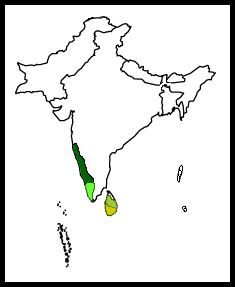Alternative names: Black-headed Babbler; Black-fronted Babbler
- Dumetia atriceps
Rhopocichla atriceps
Identification
13cm. A small compact babbler with a variable dark head.
Adults
- Short square-tipped tail
- Yellow eyes
- White throat, breast and belly
- Black crown and cheek in nominate race
- Sooty brown in bourdilloni
- Brown crown in siccata and nigrifrons (see picture)
Juvenile
- Black on head less sharply defined
Distribution
| India and Sri Lanka. In India found in the Western Ghats, from about Belgaum to the south. In Sri Lanka found in the centre and the south-west. Locally common. | |
| Legend • R. a. atriceps; year-round |
Taxonomy
This is a polytypic species[1] consisting of 4 subspecies.
Subspecies
- D. a. atriceps
- Central India (Western Ghats from Bombay to Nilgiri Hills)
- D. a. bourdilloni
- Hill forests of southwestern India (Kerala)
- D. a. siccata
- Arid north, east and central hills of Sri Lanka
- D. a. nigrifrons
- Wet lowlands of southwestern Sri Lanka
This bird has also sometimes been placed in the genus Alcippe.
Habitat
Undergrowth in broadleaved evergreen forest. Also found around clearings, in secondary growth, abandoned and overgrown plantations, bamboo, sholas or thickets near streams or marshes. In India mainly between 600 and 1800m, in Sri Lanka up to 2100m.
Behaviour
A skulking bird, often first heard and then seen. Often found in small parties up to a dozen birds, usually near the ground. Sometimes seen with other babblers or in bird waves.
Diet
Feeds on insects
Breeding
May breed year round, in India mainly from March to July, in Sri Lanka from October to May. Building its nest in thick vegetation, creating a loose dome. Lays 2 eggs. Also known to build cock nests, untidy domes in full view, not used for breeding but sometimes used as roosting sites.
Resident, no movements known.
Vocalisation
A rattling call.
References
- Rasmussen, PC and JC Anderton. 2005. Birds of South Asia: The Ripley Guide. Barcelona: Lynx Edicions. ISBN 978-8487334672
- Grimmett, R, C Inskipp, and T Inskipp. 1998. Birds of the Indian Subcontinent. London: Christopher Helm. ISBN 978-0713640045
- Kazmierczak, K and B van Perlo. 2000. A Field Guide to the Birds of the Indian Subcontinent. New Haven: Yale Univ. Press. ISBN 978-0300079210
- Del Hoyo, J, A Elliott, and D Christie, eds. 2007. Handbook of the Birds of the World. Volume 12: Picathartes to Tits and Chickadees. Barcelona: Lynx Edicions. ISBN 978-8496553422
- Clements, J. F., T. S. Schulenberg, M. J. Iliff, S. M. Billerman, T. A. Fredericks, J. A. Gerbracht, D. Lepage, B. L. Sullivan, and C. L. Wood. 2021. The eBird/Clements checklist of Birds of the World: v2021. Downloaded from https://www.birds.cornell.edu/clementschecklist/download/
Recommended Citation
- BirdForum Opus contributors. (2024) Dark-fronted Babbler. In: BirdForum, the forum for wild birds and birding. Retrieved 25 April 2024 from https://www.birdforum.net/opus/Dark-fronted_Babbler
External Links
Search by scientific name Dumetia atriceps":
Search by common name:
GSearch checked for 2020 platform.








